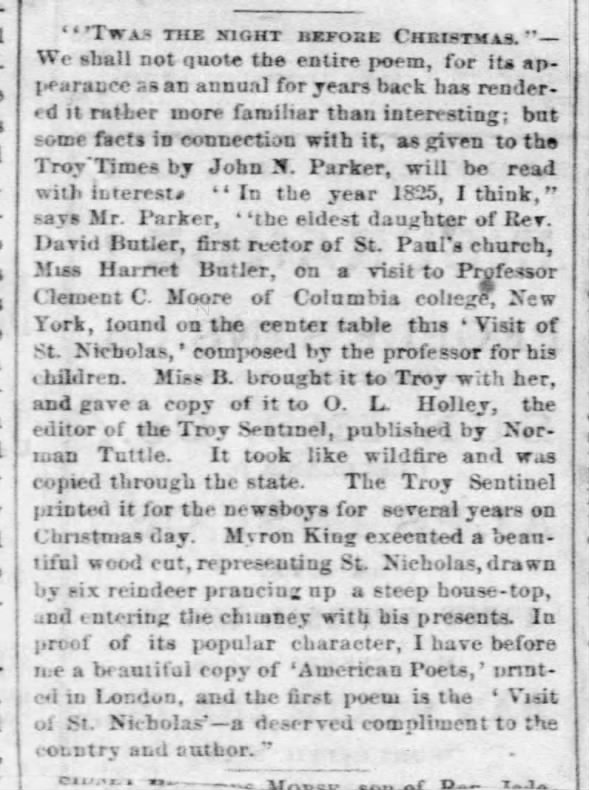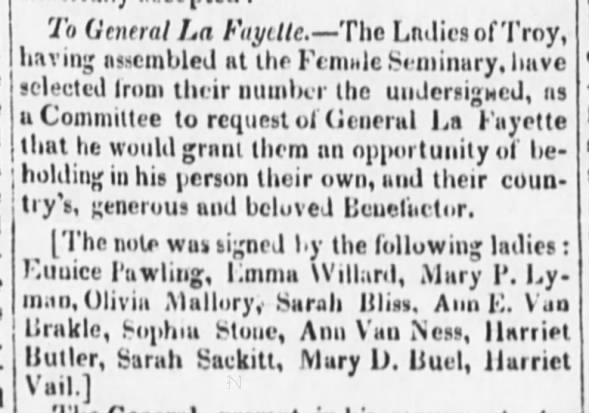Transmission history
The piece was first published in the Troy Sentinel, on December 23, 1823, with an introductory notice by the Editor, Orville L. Holley, Esq., and again two or three years after that. At the time of its first publication I did not know who the Author was — but have since been informed that you were the author. I understood from Mr. Holley that he received it from Mrs. Sackett, the wife of Mr. Daniel Sackett who was then a merchant in this city. It was twice published in the Troy Sentinel; and being much admired and sought after by the younger class, I produced the engraving which you will find on the other side of this sheet, and have published several editions of it.
--Accessible via the Museum of the City of New York
https://www.mcny.org/story/clement-clarke-moore-and-santa-city
These lines were composed for his two daughters, as a Christmas present, about 40 years ago.—They were copied by a relative of Dr. Moores in her Album, from which a copy was made by a friend of hers, from Troy, and, much to the surprise of the Author, were published (for the first time) in a Newspaper of that city.—
-- Letter from T. W. C. Moore to the Librarian of the New-York Historical Society, dated March 15, 1862 and first published in The New York Historical Society Quarterly Bulletin 2.4 (January 1919) pages 111-115.
Most likely Sarah Sackett was the second copyist, the Troy "friend" of the visiting "relative" who first copied the lines into her "Album" or commonplace book from the author's manuscript. The identity of the first copyist was revealed, maybe for the first time, in the account that "Colonel" John Tappan Parker supplied to the Troy Daily Times where it was printed on December 23, 1871. Transcribed below, the published 1871 testimony from John T. Parker, a well-informed and well-respected citizen of Troy NY, has received comparatively little attention from commentators on the authorship of The Night Before Christmas.
THE "VISIT OF ST NICHOLAS"—MOORE'S POEM—SOME ACCOUNT OF ITS HISTORY—There is scarcely a boy or girl in the land who has not read the poem entitled "A Visit of St. Nicholas," commencing with the familiar lines:
" 'Twas the night before Christmas, when all through the houseNot a creature was stirring, not even a mouse."and there are many who even know the poem by heart. It has preserved the author's name from oblivion; and it is an interesting fact to know that Mr. Moore was indebted to a Troy lady for first bringing it to the notice of the public. Indeed, the poem seems to have had something of a Trojan origin; the circumstances of which our well known fellow-citizen John N. Parker [typo for John T. Parker, T for Tappan], thus recounts in a letter to the Times:Presuming you will publish, as usual, the "Visit of St. Nicholas," quoted above, I send you the enclosed history of it for the benefit of the young Trojans who sleep with one eye open on the night before Christmas. As it has a Trojan birth, it may interest even the editor to hear its narrative as related by me. In the year 1825 I think [1822, actually], the eldest daughter of Rev. David Butler, first rector of St. Paul's church, Miss Harriet Butler, on a visit to Prof. Clement C. Moore of Columbia College, New York, found on the centre table this 'Visit of St. Nicholas,' composed by the Professor for his children. Miss B. brought it to Troy with her, and gave a copy of it to O. L. Holley, the editor of the Troy Sentinel, published by Norman Tuttle. It took like wildfire, and was copied through the state. The Troy Sentinel printed it for the news boys for several years on Christmas day. Myron King executed a beautiful wood cut, representing St. Nicholas on his sleigh, drawn by six reindeer prancing up a steep house-top, and entering the chimney with his presents. In proof of its popular character, I have before me a beautiful copy of "American Poets," printed in London, and the first poem is the "Visit of St. Nicholas"—a deserved compliment to the country and author. Wishing you and yours a right merry Christmas, Mr. Editor, I remain yours,
JOHN T. PARKER.
-- Troy Daily Times. December 23, 1871: 3 col 1.
Reprinted in the Rochester Democrat and Chronicle on Christmas Day 1871:

A longtime resident of Troy, John T. Parker (1803-1874) must have known Miss Harriet Butler (1791-1865), the Troy lady he credits by name with copying "Visit" and supplying it to Orville L. Holley. And Harriet's younger brother, Clement Moore Butler. Parker's 1871 narrative is informed by personal knowledge of Troy and its leading citizens including their father, the well-regarded pastor of St. Paul's Episcopal Church. Indeed, Harriet's father David Butler officiated in 1834 at the wedding of John T. Parker and Martha Lasell.
MARRIED. On Wednesday afternoon, at St. Paul’s Church, by the Rev. David Butler, Mr John T Parker to Miss Martha Lasell, daughter of Mr Elias Lasell, all of this city.
-- Troy Budget, January 10, 1834.
John's wife Martha Lasell Parker (1810-1903) attended the Troy Female Seminary, as the Emma Willard School was then called. Fourteen-year-old Martha Lasell was still a pupil there in September 1824 when the ladies of Troy welcomed the Marquis de Lafayette during his triumphant tour of the United States. As reported previously on Melvilliana, Lafayette was persuaded to visit the Female Seminary after receiving a formal invitation signed by Emma Willard and eleven leading women on the Committee of Arrangements including Harriet Butler and Sarah Sackett. The names of the two ladies who introduced Santa Claus to Troy in December 1823 appeared together on the signed note to General Lafayette from the Committee of Arrangements.

To General La Fayette.— The Ladies of Troy, having assembled at the Female Seminary, have selected from their number the undersigned, as a Committee to request of General La Fayette that he would grant them an opportunity of beholding in his person thier own, and their country's, generous and beloved Benefactor.
[The note was signed by the following ladies: Eunice Pawling, Emma Willard, Mary P. Lyman, Olivia Mallory, Sarah Bliss, Ann E. Van Brakle, Sophia Stone, Ann Van Ness, Harriet Butler, Sarah Sackitt, Mary D. Buel, Harriet Vail.] --New York Evening Post, September 23, 1824.
As a schoolgirl, John T. Parker's future wife Martha Lasell Parker may already have known both Harriet Butler and Sarah Sackett. Near the close of the 19th century, Martha recalled the visit of Lafayette as a highlight of her time at the Troy Female Seminary:
When La Fayette visited the school in 1824, Miss Lassell was still at the Seminary, and participated in the ovation paid to him. The young girls were dressed in white frocks and gay ribbons. A bower of evergreen was erected across the Park to the Seminary building.
Mrs. Willard, attended by her teachers, met General La Fayette at the north gate, while the scholars followed in line, singing an ode of welcome which Mrs. Willard had written for the occasion. --Emma Willard and Her Pupils, edited by Mrs. A. W. Fairbanks (New York: Mrs. Russell Sage, 1898) page 74.
Harriet Butler was 32 years old in 1823; Sarah Sackett just 30 when she reportedly handed Orville Holley a copy of "A Visit from St Nicholas" for publication in the Troy Sentinel. Ten months later they collaborated with Emma Willard and others on the reception of Lafayette. Perhaps other civic and charitable projects brought them together as well, although they worshipped in different places--Harriet of course at St. Paul's Episcopal Church, Sarah at the First Presbyterian Church. Were Miss Butler and Mrs. Sackett ever employed by Mrs. Willard as teachers or assistants at the Troy Female Seminary?
Harriet Butler died in 1865, on the day after Christmas.
 |
| Troy Daily Times - December 29, 1865 |
 |
| Troy Sentinel - April 27, 1827 via NYS Historic Newspapers |
Sarah H. Sackett died in Lansingburgh on June 23, 1867, eighteen months after the passing of her Troy friend Harriet Butler.
 |
| Troy Weekly Times - June 29, 1867 via NYS Historic Newspapers |
DIED.
... In Lansingburgh, at the residence of her nephew, Wm S. Hawley, June 23d, Mrs SARAH H., relict of Daniel Sackett, late of Troy, aged 74 years. --Troy Weekly Times, June 29, 1867
The perfunctory announcement of Sarah Sackett's death in the Times prompted this heartfelt tribute signed "E. D." and published in the Troy Daily Times on July 6, 1867.
 |
| Troy Daily Times - July 6, 1867 via fultonhisotry.com |
Obituary.
When an aged saint whose Christian course for more than two score of years has been one of untiring faithfulness and well-doing in the church of Christ, a life-long exhibition of kindness and good will to all around; I say when such a one departs this earthly tabernacle, the occasion seems to demand something more than a passing notice in a daily journal. Such a one has recently been suddenly stricken down in the midst of continued usefulness in the church and the world. All who were familiar with the dear expressive face, the gentle, graceful Christian manners and conversation of the late Mrs. Daniel Sackett, were pained when they read in the Times a few days since, the words which told them of her demise. Though Mrs. S. had not been a constant resident of Troy for a few years past, yet she retained her connection in the communion of the Second Presbyterian Church, Fifth street. Only two weeks previous to her death she came back to the city to spend a Sabbath of sacramental privileges with the church of her earlier love. Though the old church building, dear to the memory of all hearts who once worshipped there, had been swept away by the "destruction that wasted at noonday" and a more beautiful and commodious one erected, yet to her heart, a more thrilling and heart-touching memory must have come, when she remembered that of all that goodly company with whom she united more than forty years by-gone, in the original organization of that same church, probably but one with herself was spared by the hand of death or change to sit down on that occasion at the table of the Lord.
But her work is done, she has gone to her rest quietly, peacefully--gone to the fellowship of Heaven--to a blessed re-union with one, to her, "not lost, but gone before," and to whose memory, her widowed life ever paid a beautiful tribute of devotion.
E. D.
"was very intimate in the family at Hyde Park, and he read to the children his much beloved poem “The Night Before Christmas” from the manuscript before it ever was published."
-- Historical Notes of St James Parish, Hyde Park-on-Hudson, New York (Poughkeepsie, 1913) page 38.
As far as we know, however, not one of those lucky Bards was bold enough to copy Moore's poem and share it with others via the local newspaper.
Holiday Toast from Melvilliana
[Nineteenth-century style, to be drunk standing.]
Here's to the ladies of Troy who launched Santa Claus and fêted Lafayette... true in heart and soul, they knew what to do with a "generous and beloved Benefactor."
 |
| via Library of Congress |
- Harriet Butler and Sarah Sackett in Troy, 1824
https://melvilliana.blogspot.com/2018/12/harriet-butler-and-sarah-sackett-in.html
- First printing of A Visit from St Nicholas
https://melvilliana.blogspot.com/2019/04/first-printing-of-visit-from-st-nicholas.html



Got to love this. Harriet was a bridesmaid at the wedding of Laurent and Eliza Clerc. Laurent was a founder of the American School for the Deaf in Hartford CT. Harriet's father married the couple on May 3rd, 1819 at St. Pauls Church.
ReplyDeleteWonderful connection and news to me. Thank you!
Delete